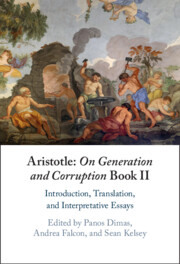 Aristotle: On Generation and Corruption Book II
Aristotle: On Generation and Corruption Book II from Part I - Introduction and Interpretative Essays
Published online by Cambridge University Press: 10 November 2022
After arguing that each of the elements can come to be out of each of the three others, the bulk of GC II 4 presents and compares the speed and ease of three mechanisms by which the elements change into one another. While scholars have thought these three mechanisms are narrowly focused on individual changes, i.e., the three ways an element can change into each of the others, on my interpretation, the three mechanisms describe every possible complete cycle by which all four elements come to be, either singly or pairwise. Thus, I understand Aristotle’s interest in speed and ease as an interest in which mechanism generates all four elements most quickly and easily. My interpretation shows Aristotle builds on passages other scholars and translators have deemed textual oddities or mistakes and has the additional advantage of showing that Aristotle’s interest in the relative speed and ease of cycles of elemental transformation lays the groundwork for his metaphysical and scientific projects in GC II 10 and the Meteorology.
To save this book to your Kindle, first ensure no-reply@cambridge.org is added to your Approved Personal Document E-mail List under your Personal Document Settings on the Manage Your Content and Devices page of your Amazon account. Then enter the ‘name’ part of your Kindle email address below. Find out more about saving to your Kindle.
Note you can select to save to either the @free.kindle.com or @kindle.com variations. ‘@free.kindle.com’ emails are free but can only be saved to your device when it is connected to wi-fi. ‘@kindle.com’ emails can be delivered even when you are not connected to wi-fi, but note that service fees apply.
Find out more about the Kindle Personal Document Service.
To save content items to your account, please confirm that you agree to abide by our usage policies. If this is the first time you use this feature, you will be asked to authorise Cambridge Core to connect with your account. Find out more about saving content to Dropbox.
To save content items to your account, please confirm that you agree to abide by our usage policies. If this is the first time you use this feature, you will be asked to authorise Cambridge Core to connect with your account. Find out more about saving content to Google Drive.